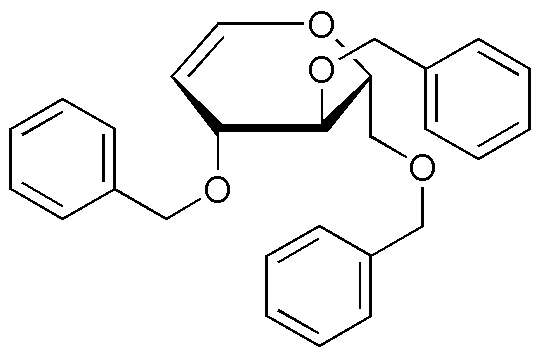Tri-O-benzyl-D-glucal is widely utilized in research focused on:
- Synthetic Organic Chemistry: This compound serves as a versatile building block for the synthesis of complex carbohydrates and glycosides, enabling researchers to create a variety of sugar derivatives with tailored properties.
- Pharmaceutical Development: It is employed in the development of glycosylated drugs, which can enhance the bioavailability and efficacy of therapeutic agents, particularly in targeting specific biological pathways.
- Bioconjugation Techniques: Tri-O-benzyl-D-glucal is used in bioconjugation processes to attach sugars to proteins or other biomolecules, improving their stability and functionality in drug delivery systems.
- Research on Glycobiology: This compound aids in the study of carbohydrate-protein interactions, providing insights into cellular recognition processes, which are crucial for understanding various biological functions.
- Food Industry Applications: It can be utilized in the formulation of sweeteners or flavor enhancers, offering a more natural alternative to synthetic additives while maintaining desirable taste profiles.
General Information
Properties
Safety and Regulations
Applications
Tri-O-benzyl-D-glucal is widely utilized in research focused on:
- Synthetic Organic Chemistry: This compound serves as a versatile building block for the synthesis of complex carbohydrates and glycosides, enabling researchers to create a variety of sugar derivatives with tailored properties.
- Pharmaceutical Development: It is employed in the development of glycosylated drugs, which can enhance the bioavailability and efficacy of therapeutic agents, particularly in targeting specific biological pathways.
- Bioconjugation Techniques: Tri-O-benzyl-D-glucal is used in bioconjugation processes to attach sugars to proteins or other biomolecules, improving their stability and functionality in drug delivery systems.
- Research on Glycobiology: This compound aids in the study of carbohydrate-protein interactions, providing insights into cellular recognition processes, which are crucial for understanding various biological functions.
- Food Industry Applications: It can be utilized in the formulation of sweeteners or flavor enhancers, offering a more natural alternative to synthetic additives while maintaining desirable taste profiles.
Documents
Safety Data Sheets (SDS)
The SDS provides comprehensive safety information on handling, storage, and disposal of the product.
Product Specification (PS)
The PS provides a comprehensive breakdown of the product’s properties, including chemical composition, physical state, purity, and storage requirements. It also details acceptable quality ranges and the product's intended applications.
Certificates of Analysis (COA)
Search for Certificates of Analysis (COA) by entering the products Lot Number. Lot and Batch Numbers can be found on a product’s label following the words ‘Lot’ or ‘Batch’.
Numéro de catalogue
Numéro de lot/série
Certificates Of Origin (COO)
This COO confirms the country where the product was manufactured, and also details the materials and components used in it and whether it is derived from natural, synthetic, or other specific sources. This certificate may be required for customs, trade, and regulatory compliance.
Numéro de catalogue
Numéro de lot/série
Safety Data Sheets (SDS)
The SDS provides comprehensive safety information on handling, storage, and disposal of the product.
DownloadProduct Specification (PS)
The PS provides a comprehensive breakdown of the product’s properties, including chemical composition, physical state, purity, and storage requirements. It also details acceptable quality ranges and the product's intended applications.
DownloadCertificates of Analysis (COA)
Search for Certificates of Analysis (COA) by entering the products Lot Number. Lot and Batch Numbers can be found on a product’s label following the words ‘Lot’ or ‘Batch’.
Numéro de catalogue
Numéro de lot/série
Certificates Of Origin (COO)
This COO confirms the country where the product was manufactured, and also details the materials and components used in it and whether it is derived from natural, synthetic, or other specific sources. This certificate may be required for customs, trade, and regulatory compliance.


